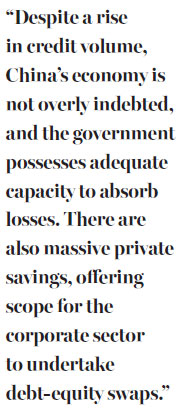Debt picture offers cause for confidence
Close examination of the figures shows that China's finances put it in a favorable position to weather current uncertainties
China's debt-to-GDP ratio has risen to unprecedented levels, stoking fears of a looming full-blown debt crisis. Such fears are reinforced by related economic risks: (a) a possible hard landing; (b) excessive liquidity coupled with deflation; (c) overcapacity; and (d) sluggish international trade.
As China's economy is beginning to show signs of stabilizing, fears of a hard landing and deflation have largely receded, at least for now. Nevertheless, despite continuing efforts to rein them in, problems of overcapacity remain. Meanwhile, excessive liquidity is being ameliorated, with surging outbound direct foreign investments and outflow of capital driven by expectations of a weakening renminbi. This is partly reflected in China's foreign exchange reserves, which peaked at nearly $4 trillion in June 2014 and fell to about $3.2 trillion by January 2016.
Against this backdrop, I now focus on China's debt problem.
According to a recent McKinsey report, the level of gross debt in 2014 was 282 percent of GDP. This includes government debt (55 percent of GDP) and debt owed by financial institutions (65 percent of GDP), nonfinancial corporations (125 percent of GDP) and households (38 percent of GDP). Recent estimates suggest that corporate debt may have risen above 150 percent of GDP by early 2016.
China has traditionally had a low level of foreign-currency external debt. At $800 billion (753 billion euros; 645 billion) or 7 percent of GDP in 2015, it is much lower than virtually any other major emerging market.

China has an exceptionally high level of corporate deposit holding, equivalent to 90 percent of GDP, compared with 7 percent in the United States. Albeit a sign of low efficiency of capital utilization, loans are often recycled back to the lending bank as deposits. Nevertheless, this enables the banks to earn high interest spreads and acts as a cushion against exigencies. According to the People's Bank of China, at the end of 2014, total bank deposits amounted to some $19 trillion, while the total loan book stood at $14 trillion. About 45 percent of bank deposits were personal savings while 50 percent came from enterprises.
China's household debt (and gearing) remains comparatively low. Housing price inflation and speculation notwithstanding, the contention of a massive mortgage crisis is not borne out.
Despite a rise in credit volume, China's economy is not overly indebted, and the government possesses adequate capacity to absorb losses. There are also massive private savings, offering scope for the corporate sector to undertake debt-equity swaps.
Nonperforming bank loans are estimated to range from 6 to 7 percent to as much as 25 percent for some smaller banks. However, unlike those in the West, thanks to "financial repression" limiting deposit interest rates, Chinese banks derive a vast proportion of their funding and profits from stable bank deposits, rather than loan spreads. Moreover, China's banks are mandated to have about 17 percent of required reserves at the People's Bank of China. By way of further insurance, a bank deposit insurance program has been in operation since May 2015.
The balance sheet of the government as a whole is healthier than sometimes surmised. The state has a treasure trove of assets - including its massive foreign exchange reserves, ownership stakes in state enterprises and foreign investments through the sovereign wealth fund.
Moreover, a significant proportion of China's debt, particularly at the local government level, is going into building infrastructure for the largest and fastest urbanization drive in human history. The aim is to turn China into a middle-class country, with long-term social, economic and political benefits. These loans cannot be adequately evaluated in purely commercial terms.
As for state-owned enterprises, risks should not be based solely on liabilities. Taking into account their massive asset base, their loan-to-equity ratios remain largely manageable.
The International Monetary Fund computes a measure of augmented public debt, which includes various types of local government borrowing, including off-budget borrowing by local government financing vehicles via bank loans, bonds, trust loans, and other funding sources. By this measure, China's public debt-to-GDP ratio was estimated to be 60 percent in 2015, still below the public debt-to-GDP ratios of major advanced economies.
Moreover, China's net foreign assets amounted to $1.6 trillion at the end of 2015, more than enough to cover all of its foreign liabilities.
The author is a leading China commentator and chairman of Andrew Leung
International Consultants. The views do not necessarily reflect those of China Daily.
(China Daily Africa Weekly 11/25/2016 page9)
















